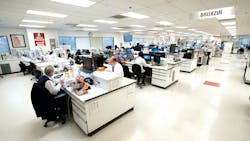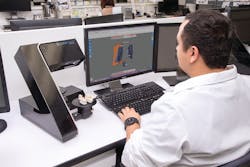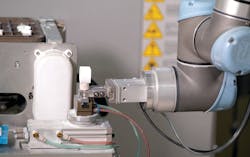Adding value through lean manufacturing and beyond
David Leeson
Lean manufacturing, the prominent business practice of minimizing waste (i.e., time, materials, and processes) while maximizing productivity, has found a comfortable footing in dental laboratories. The disruption caused by new and emerging laboratory technologies portends massive improvements in efficiency, speed, and consistency.
More specifically, lean manufacturing (also known as operational excellence) has demonstrated its effectiveness in achieving three key laboratory objectives: 1) streamlining workflows; 2) eliminating wasteful downtime; and 3) empowering 24-hour production cycles. Let’s take a more detailed look at these improvements individually.
Streamlining workflows
Irvine, California, is the home of Glidewell Intelligent Manufacturing (IM), a laboratory and production environment built to maximize lean benefits. One key means of streamlining workflows in this laboratory is through the use of CT scanning. When a conventional dental impression arrives at the Glidewell IM facility, a micro-CT scan is created so the impression can be quickly digitized and designed electronically. This modernized process achieves two key objectives—it speeds the design and production timeline while simultaneously ensuring the improved accuracy of restorations.
“The main reason for our company implementing lean manufacturing is to disrupt the market by providing value to our customers, particularly in the areas of price, speed of service, and consistent quality,” said Dzevad Ceranic, executive vice president of laboratory operations for Glidewell. “For example, we’re able to complete our cases in five days, with the majority of cases completed in three. Because we can achieve this without adding additional resources—labor, equipment, and so on—we’re able to add value without increasing the price.”Eliminating wasteful downtime
Conventionally, the design and production of restorations mandated the creation of a stone model based on the patient’s impression. This process was lengthy and somewhat cumbersome, and the removal of the set stone frequently resulted in the destruction of the impression, meaning a new impression would be required if restorations were ill-fitting or if margins were inaccurate. Conversely, digitization of the impression results in a highly accurate computer file that supports: 1) more precise restoration design; 2) a master file to which technicians can refer in the unlikely event that remakes are required; and 3) long-term storage of the file for reference on future restorations.
Downtime is further limited in the Glidewell IM lab by leveraging what the company calls Glidewell Applied Restorative Intelligence (GARI)—a proprietary artificial intelligence protocol wherein data from many years of company records in executed restoration designs is applied to each new design. This intelligence application informs and supports the design and manufacturing of restorations that are better, faster, and more consistent than previously achieved.Disruption from new technology can and will turn this industry on its head. Take a look at the transition from porcelain fused to metal (PFM) to monolithic zirconia, for example. With all the lean and continuous improvement in the world, the cost of a PFM made via pressing and investment casting could never yield a crown that is as inexpensive as monolithic zirconia. And new technology and disruptors are on the way.Empowering 24-hour production
The “always on” potential of technology paves the way for laboratories such as Glidewell and others to maintain 24-hour production cycles, and the benefits of the resulting rapid turnaround are significant: patients spend less time in temporaries, and more rapidly completed cases get dental professionals paid faster (and perhaps more frequently).
Conclusion
What’s in it for the dentist?
- Quality: Less chairside adjustment so the dentist can attend to more patients, resulting in growth for the practice.
- Speed of service: Consistent turnaround time allows the dental office to schedule patients with high confidence knowing that the crown will be in the office when expected.
- Cost savings: Implementing operational excellence throughout production enables dental laboratories to increase efficiency and continue to add value for customers without increasing price.
Making quality dental care accessible to more patients requires the utilization of imagination and technology not previously leveraged in the dental industry. Adherence to lean manufacturing principles is the engine bringing that mission into reality.
More: Lean dentistry: A crash course in kaizen, Six Sigma, and lean manufacturing for dental practices
DAVID LEESON is vice president of engineering at Glidewell Dental.

